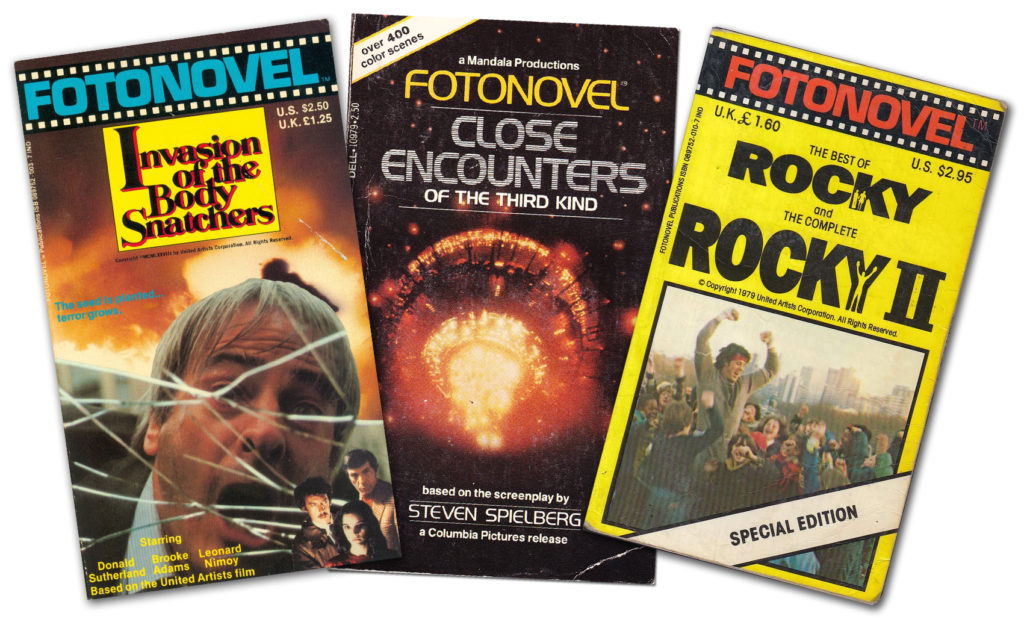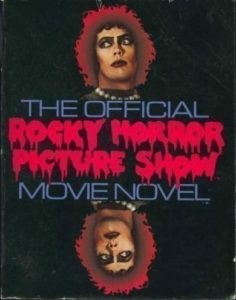Fotonovels, are they true movie novelizations or just a picture books? In the world of novelizations, tie-ins, and the like it seems like there are endless variations on the concept of movie to book adaptation. Like in any niche genre or collecting hobby there are a lot of unspoken “rules” as to what defines or counts for inclusion, and novels based on movies are certainly no exception. One of the weirdest variations in the world of film novelizations are a small subset of adaptations that were sort of popular in the late 70s and early 80s called Fotonovels (a play on combining Photos and Novels.) Basically, these mass market paperbacks were 150-250 page novels that were chock full of film stills laid out in a comic book-style format complete with speech bubbles, inner monologue boxes and captions that re-tell the story of the movie visually and chronologically. Imagine if, instead of just 8 pages of color photos inserted in the middle of a novelization or tie-in, the entire book were comprised of scene by scene color photos.

There were a bunch of Fotonovels published in the late 70s for both television and film adaptations including such works as Star Trek, Battlestar Galactica, Rocky, Grease, the Pink Panther (films), Close Encounters of the Third Kind and notoriously the Rocky Horror Picture Show. So the question for collectors and catalogers arises, are Fotonovels movie novelizations?
In the genre of film to book adaptations there are multiple tiers of what could be considered a novelization. For instance, whereas a book that had been published well before a film and was simply re-issues with a new cover and summary that more closely hues to the branding of a film adaptation is merely a tie-in and would not be considered a novelization, many fans and collectors would however consider a young adult adaptation that severely streamlines the story and leave out portions of the movie storyline in the process to be novelizations. So if the question is one of timing, i.e. what came first, the script or the manuscript, then Fotonovels would surely fall into the realm of the novelization.
Of course, being comprised of mostly movie stills, does the Fotonovel break the fundamental tenant of a novel by not being strictly prose? Or, as a variation of Italian comic books known as “fumetti” (comics that use photo collages instead of illustrations to convey a story), would Fotonovels be a form of sequential art adaptation? Do comic book adaptations count as novelizations? There were a number that were published in the mass market paperback format in the 70s and 80s including adaptions of such films as Dragonslayer and Star Wars, volumes that collected the Marvel Comics limited series into books. Though both of those also have traditional prose novelizations, are they any less of an adaption? When you think about it, one of the main purposes of film novelizations to begin with was to provide an affordable way for audience members and fans to “relive” the film in an era where there weren’t many affordable home viewing options. Wouldn’t a Fotonovel be a realization of the essence of this idea, experiencing a film again, only in the form of a book?
Whereas there are some Fotonovels for films that also had a more traditional novelization, as in the case of Close Encounters of the Third Kind, Rocky and Rocky II, there are also Fotonovels for films that had no other form of adaptation including The Incredible Shrinking Woman, The Jerk, or Invasion of the Body Snatchers (the 1978 film version.) So again, as a collector it begs the question, do these count?


